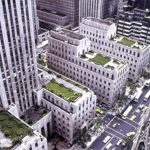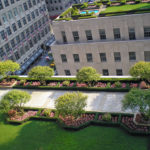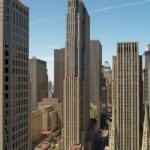
Additional Resources
Rockefeller Center is located in midtown Manhattan, between 48th and 51st Streets and Fifth and Sixth Avenues. Visit the Rockefeller Center website and its Art and History page.
Case Studies
Wikipedia; see the Rockefeller Center Roof Gardens along with many other case studies in the excellent book Roof Gardens: History, Design, and Construction, by Theodore Osmundson, FASLA, 1999.
Rockefeller Center is a U.S. national historic landmark in the heart of Midtown Manhattan at one of New York’s most inspiring locations.
“Conceived over 100 years ago by John D. Rockefeller Jr. as a “city within a city,” Rockefeller Center has long been a hub of remarkable art, style, and entertainment. His inspiring vision continues to this day.” ~ Rockefeller Center
The five roof gardens perched atop the 7th floor of Rockefeller Center have been in existence since the mid 1930’s and continue to provide beautiful greenspace as well as visual ammenity for the surrounding skyscrapers. The Rockefeller Center roof gardens were constructed between 1933 and 1936. Rockefeller Center is a complex of 19 commercial buildings covering 22 acres between 48th and 51st Streets in New York. Built by the Rockefeller family, it is located in the center of Midtown Manhattan, spanning between Fifth Avenue and Seventh Avenue. It was declared a National Historic Landmark in 1987.Three of Rockefeller Center’s secluded roof gardens can be viewed from the Top of the Rock observation decks, atop the GE Building, where panoramic views of Central Park and the Empire State Building can also be seen.
In Daniel Okrent’s book, “Great Fortune: The Epic of Rockefeller Center,” he says the Gardens in the Sky were originally open to the public but operated at an annual loss of $45,000. Okrent describes the gardens as built: “The roofs on the four low buildings on Fifth were done up in styles appropriate to the buildings’ themes — cobblestones from the streets of Italian towns and two stone plaques from the Roman Forum framed the plantings on the Palazza d’Italia, for instance, and the British Empire’s Building’s umbrella-topped garden tables, where tenants could take tea in clement weather, were surrounded by well-trimmed yews and other hedge plants. But the gardens meandering around the eleventh-floor setback, on the RCA building, 140 feet above street level, were so lavish they made the tops of the low buildings look like suburban backyards.”
The first two roof gardens to be built were the Maison Francais and the British Empire Building, completed in March, 1931. They were designed by British horticulturalist Ralph Hancock, and include central parterres of lawn framed by privet hedges and feature fountains and ponds. The two seventh floor roofs of the Palazzo d’Italia and the International Building North were designed by horticulturalist A. M. Vanden Hock in 1936, and are elaborate Mediterranean-style gardens measuring 229′ x 52′ each. The fifth roof garden is on the tenth floor of the RCA Building and was designed by Ralph Hancock in 1934. Originally it contained styles from several periods, and now only a smaller garden area of about 3/4 of an acre remains (Osmundson, 1999 – see below).
 Greenroofs.comConnecting the Planet + Living Architecture
Greenroofs.comConnecting the Planet + Living Architecture







